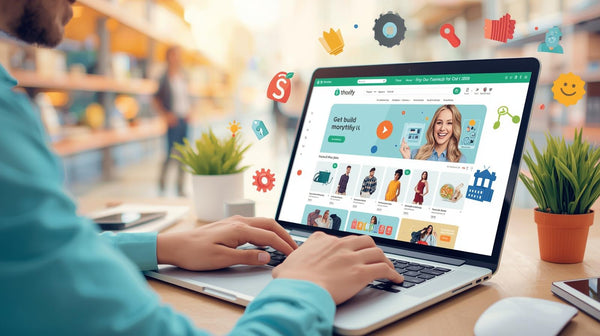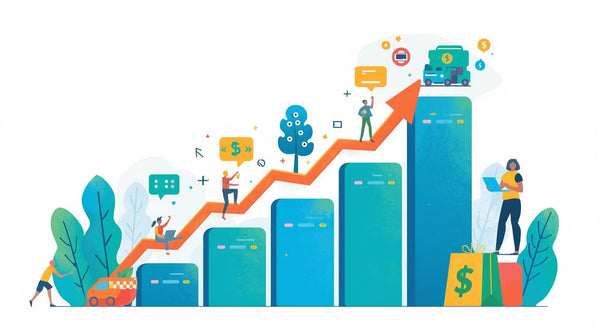When most people hear the term point of sale, they picture a checkout counter in a retail store, complete with a cash register and receipt printer. That image isn’t wrong but it’s only one piece of the puzzle.
Today, POS has evolved into something much bigger. For Shopify merchants, it represents the entire transaction moment the bridge between browsing and buying whether online, in-store, or on a mobile device.
Think of POS as the place where a sale actually happens. It’s the system that:
-
Updates Inventory – Adjusts stock levels in real time after each purchase.
-
Processes Payments – Handles cards, digital wallets, BNPL, or cash.
-
Generates Receipts – Paper or digital, depending on customer preference.
-
Strengthens Customer Relationships – Saves data for loyalty programs, personalized offers, and future sales.
Why Does POS Matter for Shopify Merchants?
Your POS isn’t just a tool it’s the beating heart of your business. A smooth, integrated system can mean the difference between:
-
A frustrated shopper abandoning checkout
vs. -
A happy customer becoming a repeat buyer
No matter what you sell apparel, food, digital products, or services the way you manage POS directly shapes the customer experience.
What This Guide Covers
In this guide, we’ll explore:
-
What POS really means today
-
Why it’s critical for Shopify businesses
-
How POS works behind the scenes
-
The advantages and disadvantages of different POS setups
-
The future of POS in ecommerce
By the end, you’ll see why upgrading your POS isn’t just an operational choice it’s a growth strategy for your Shopify store.

1. What is Point of Sale?
At its core, a point of sale (POS) is the exact moment and place where a customer completes a purchase. It’s the bridge between decision and payment the point where intent turns into revenue.
For traditional retail, the POS has always been tied to the physical world. Think about:
-
A checkout counter with a cash drawer and receipt printer.
-
A card reader at a weekend pop-up market.
-
A self-service kiosk in a café or fast-food outlet.
But in the Shopify ecosystem, the definition expands well beyond the physical store. The POS can also be:
-
The Shopify online checkout page where a customer enters card details and hits “buy now.”
-
A mobile POS app that lets staff sell products at events or trade shows with nothing more than a tablet or phone.
-
An integrated retail POS system that automatically syncs in-store and online inventory, so you never oversell.
The key thing to understand: POS is not just a single machine. It’s an entire system a combination of hardware, software, and processes that makes buying possible and keeps your records organized.
When you zoom out, the point of sale does three important jobs:
-
Captures the transaction – from product selection to final payment.
-
Records the data – updating sales history, receipts, and reports.
-
Connects the dots – linking inventory, customer information, and even marketing tools.
That’s why modern POS is central to running a Shopify business. It’s no longer just “where you take money” it’s where customer experience, operations, and growth strategies all intersect.
2. Why Point of Sale Matters
The point of sale is more than just a place to swipe a card or scan a barcode. It’s the heartbeat of every business transaction the moment that shapes how a customer feels, how data flows, and how a business grows. For Shopify merchants, a POS system isn’t just a tool, it’s a growth engine.
Here’s why it matters:
-
Creates a Smooth Checkout Experience
Customers today expect speed and simplicity. A Shopify POS ensures transactions are quick, accurate, and seamless whether online, in-store, or at a pop-up. A smooth checkout builds trust, reduces abandoned carts, and encourages repeat purchases. -
Connects All Sales Channels
Modern shoppers don’t stick to one channel. They browse on Instagram, compare on a website, and sometimes walk into a store. Shopify POS ties all of these touchpoints together, so no matter where the sale happens, the experience is consistent. -
Delivers Real-Time Sales Data
POS systems aren’t just about taking payments they’re about insights. With Shopify POS, every sale updates instantly, giving owners a clear picture of what’s selling, when, and where. This data fuels smarter decisions on pricing, promotions, and product strategy. -
Manages Inventory Across Locations
One of the biggest headaches for merchants is keeping inventory accurate. A connected POS solves this by automatically updating stock levels across warehouses, online stores, and physical shops. That means no more overselling or disappointing customers. -
Builds Customer Loyalty
Today’s POS systems don’t just process payments they remember customers. With profiles, purchase history, and preferences saved, Shopify merchants can tailor marketing, offer personalized discounts, and reward repeat buyers.
The reality is simple: without an efficient POS, businesses risk slow transactions, mismatched inventory, frustrated customers, and lost sales opportunities. For Shopify stores, the POS isn’t optional it’s the foundation of a smooth, scalable retail operation.

3. How Point of Sale Works in Simple Terms
If you strip it down, the point of sale is just a cycle. A flow that repeats with every transaction. But when you look closely, it’s more than just money changing hands it’s a system that ties customer experience, operations, and data together.
Here’s the cycle in action:
-
Customer Selects Products
The journey begins when a customer adds items to their cart physically in-store or digitally online. This is the “intent to buy” moment, and the POS system captures that intent. -
POS Calculates the Total
The system instantly applies taxes, discounts, promo codes, or loyalty rewards. What once took a cashier several steps is now automated, ensuring accuracy and fairness. -
Payment Processing
The customer pays using their preferred method cash, debit card, credit card, digital wallet, or even Buy Now, Pay Later (BNPL). Shopify POS makes this step frictionless, handling multiple payment types without extra hardware or software. -
Sale is Recorded and Inventory Updated
The transaction isn’t just a receipt it’s data. Every purchase reduces stock automatically, so you never have to worry about selling items you don’t actually have. For multi-location businesses, this syncing happens across all stores and warehouses. -
Data Syncs to Shopify Dashboard
Finally, the sale is logged into your Shopify admin. Merchants get a bird’s-eye view of performance top sellers, revenue by channel, peak hours all updated in real time. This integration eliminates the old headache of juggling spreadsheets or disconnected tools.
The beauty of Shopify POS is that all these steps are unified into one ecosystem. There’s no bouncing between cash registers, payment apps, and inventory software. Instead, everything is centralized payments, sales history, customer profiles, and analytics.
In simple terms, Shopify POS isn’t just a tool that “rings up sales.” It’s a connected business system that makes selling easier, faster, and smarter.

4. Types of Point of Sale Systems
Not all point of sale systems look or work the same. Over the years, POS has evolved from clunky machines to sleek cloud-based tools that fit in your pocket. For Shopify merchants, understanding the different types of POS is key to choosing the right setup for their business model.
Let’s break it down:
-
Traditional POS
Think of the classic cash register and barcode scanner. These systems are hardware-heavy, often locked into one physical location. They’re reliable but limited you can’t easily take them to a pop-up shop or sync them with an online store. Traditional POS is best suited for brick-and-mortar retailers with steady foot traffic, but it struggles when businesses want flexibility or digital integration. -
Mobile POS (mPOS)
A modern twist on POS, mobile systems turn tablets or smartphones into checkout counters. With the right POS app, you can swipe a card at a farmers’ market, process payments at a trade show, or let staff sell on the go in a busy retail space. For Shopify sellers who do events, fairs, or in-person sales alongside online orders, mobile POS is lightweight and powerful. -
Cloud-Based POS
This is where Shopify POS shines. A cloud-based system connects every sale to the web in real time. That means inventory, sales data, and customer records are always up to date whether a purchase happens in-store, online, or at an event. There’s no need for complex servers or manual backups. Everything runs on Shopify’s secure platform, giving merchants freedom to manage their business from anywhere. -
Multichannel POS
Today’s customers shop everywhere on Instagram, in physical stores, through online marketplaces, or directly from a brand’s Shopify website. A multichannel POS unifies all of these into one system. For example, if someone buys your last pair of sneakers online, the system updates your in-store stock instantly to prevent overselling. This level of integration is what makes Shopify POS especially valuable it blends ecommerce and retail seamlessly.
Which Type Wins?
For most modern Shopify merchants, cloud-based and multichannel POS systems are the clear winners. They scale with your business, integrate with other Shopify tools, and give you the flexibility to sell anywhere without losing control of data or inventory.
Traditional POS still has a role, and mobile POS is great for events but if your goal is to grow across multiple sales channels, Shopify’s cloud-based ecosystem usually makes the most sense.

5. Advantages of a Strong POS System
A good point of sale system isn’t just a tool to process payments it’s the backbone of a modern retail and ecommerce business. For Shopify merchants especially, investing in a strong POS system pays dividends across operations, customer experience, and long-term growth.
Let’s look at the key advantages:
-
Faster Transactions
Time is money. With an efficient POS, checkout becomes smooth and quick, whether it’s an in-store line or an online cart. Shorter wait times mean happier customers and the less friction at checkout, the less likely someone is to abandon a purchase. In Shopify’s ecosystem, this speed is built in, with one-tap payments and mobile-friendly checkout. -
Better Inventory Control
Gone are the days of manually counting stock. A strong POS automatically updates inventory as sales happen. If you sell a product in-store, your Shopify dashboard reflects that change instantly, ensuring you don’t accidentally oversell online. This level of control helps reduce errors, cuts down on waste, and keeps customers satisfied by showing accurate stock availability. -
Data-Driven Insights
Every transaction is a data point. A modern POS doesn’t just record sales it organizes them into patterns. You can see which products are trending, which times of day drive the most revenue, and which locations perform best. For Shopify merchants, these insights flow directly into reports that help guide smarter decisions around pricing, marketing, and product selection. -
Customer Loyalty Features
A great POS system does more than process payments it builds relationships. By storing customer profiles, past purchases, and preferences, you can personalize marketing and create loyalty programs. For example, Shopify POS allows you to offer discounts to repeat buyers, track reward points, or send personalized product recommendations. That kind of attention turns one-time buyers into long-term fans. -
Scalability
Businesses don’t stay the same size forever. A strong POS grows with you. Adding a new location, expanding into pop-up shops, or selling through a new channel doesn’t mean starting from scratch it’s just another data point in the same connected system. With Shopify POS, scaling up is as simple as syncing a new device or location.
The Big Picture
For Shopify businesses, POS isn’t just about closing sales it’s about running smarter. It streamlines workflows, reduces human error, and gives owners the visibility they need to grow with confidence. Think of it less as a cost and more as a system that pays for itself by making everything else more efficient.

7. POS and Shopify: The Perfect Match
When you think about point of sale systems, most traditional options were built for brick-and-mortar retailers first, then later adapted for online selling. Shopify flips that model on its head it’s built for ecommerce businesses from day one, with POS features designed to bridge the gap between digital and physical sales.
Here’s why Shopify POS feels like the natural choice for modern merchants:
-
Seamless Inventory Sync
One of the biggest headaches for retailers is managing stock across channels. Shopify POS solves this by automatically syncing online and offline inventory. If someone buys the last shirt in-store, your online store instantly shows it as sold out no risk of double selling or frustrating customers. -
Mobile Checkout Flexibility
Today’s customers expect convenience. Whether you’re running a pop-up shop, selling at a farmers’ market, or just need to shorten the checkout line in-store, Shopify POS lets you complete sales directly from a tablet or phone. This flexibility means you can meet customers wherever they are. -
Unified Customer Profiles
Every purchase, whether online or in person, is tied to a single customer profile. That means you can see a shopper’s full history what they bought, where they bought it, and how often they return. This makes it easier to personalize marketing, build loyalty programs, and deliver a consistent experience across all touchpoints. -
Built-In Tools for Growth
Unlike legacy POS systems that require add-ons for even basic features, Shopify POS comes with loyalty-ready tools. Gift cards, discounts, promotions, and loyalty rewards aren’t afterthoughts they’re baked into the system. This ensures you can nurture customer relationships without cobbling together third-party apps. -
Tight Integration with Shopify Payments
Shopify POS integrates seamlessly with Shopify Payments, Shopify Balance, and trusted third-party gateways. This reduces friction during checkout and ensures you can accept cards, wallets, and alternative payments without juggling separate providers. It also simplifies bookkeeping since everything feeds into the same dashboard.
The Bottom Line
For entrepreneurs juggling both ecommerce and physical sales, Shopify POS is more than just software it’s the connective tissue that makes omnichannel retail possible. It removes the silos between online and offline, giving businesses one system to manage sales, customers, and growth.

8. Point of Sale as a Growth Tool
For years, the point of sale was viewed as the finish line the place where the customer handed over money, got a receipt, and left. Today, especially with platforms like Shopify, POS is no longer just about closing a sale. It has evolved into a growth engine that fuels marketing, customer retention, and business expansion.
Here’s how Shopify merchants use POS as a strategic tool:
-
Pop-Up Stores for Market Testing
Launching a full retail store is a big commitment. With Shopify POS, merchants can set up pop-up shops at local events, malls, or shared retail spaces. These short-term experiments allow you to test new locations, products, or audiences without heavy investment. If a pop-up does well, it’s a signal that a permanent location might succeed. -
Omnichannel Selling Made Simple
Modern customers shop everywhere on websites, social platforms, and in physical stores. Shopify POS ensures all these channels are connected. Whether someone buys online and picks up in-store (BOPIS) or shops in-store and reorders online, the experience is consistent. This seamless flow builds customer trust and strengthens brand loyalty. -
Personalized Marketing from POS Data
Every transaction tells a story. Shopify POS captures data like purchase frequency, favorite products, and seasonal buying habits. Merchants can turn this information into tailored marketing campaigns such as sending discount codes to frequent buyers or promoting related products based on past purchases. Instead of generic promotions, customers receive offers that feel personal. -
Smarter Employee Management
A POS system isn’t only for customers it helps manage staff too. Shopify POS lets you assign roles, track sales performance, and monitor employee activity. This insight helps reward high performers, train new staff effectively, and ensure accountability across your retail team. -
Scaling Without the Growing Pains
Expanding into new cities, regions, or even countries is easier with a flexible POS. Shopify POS scale with you adding locations, syncing inventory, and keeping financial data centralized. You don’t have to reinvent your systems with every expansion. Growth feels less like chaos and more like a structured, repeatable process.
The Shift in Perspective
What used to be seen as “the end of the shopping journey” is now the starting point of long-term engagement. POS doesn’t just record a sale it captures insights, builds relationships, and creates opportunities for future revenue. For Shopify businesses, that makes the POS one of the most powerful growth tools available.

9. The Future of Point of Sale
The point of sale is no longer just a cash register it’s becoming the nerve center of retail. Technology and consumer behavior are pushing POS systems to evolve faster than ever, and Shopify merchants are right at the heart of this change. What we’re seeing now is only the beginning of how powerful POS will become in shaping the future of commerce.
Here are the key trends shaping tomorrow’s POS:
-
Contactless Payments as the Norm
Customers expect speed and convenience. Tap-to-pay with credit cards, mobile wallets like Apple Pay and Google Pay, and even wearables are no longer “nice-to-have” options they’re becoming essential. For Shopify stores, offering contactless payments reduces friction, increases checkout speed, and boosts customer satisfaction. -
Buy Now, Pay Later (BNPL) Integration
Flexible payment options are in high demand, especially among younger shoppers. BNPL solutions like Shop Pay Installments give customers the freedom to split purchases into manageable payments without interest. For merchants, this often translates into higher average order values and reduced cart abandonment. -
AI-Powered Insights and Automation
Artificial intelligence is finding its way into POS systems. From detecting fraudulent transactions in real time to recommending products based on buying history, AI is turning POS into a proactive business tool. Imagine a system that not only records sales but also predicts what you should stock next month that’s where we’re headed. -
Unified Commerce for a Seamless Experience
The future isn’t about keeping online and offline sales separate it’s about blending them into one unified experience. Customers want to browse online, check product availability in-store, buy on social media, and return items anywhere. Shopify POS makes this possible by keeping inventory, data, and customer profiles synced across every channel.
Looking Ahead
The future of POS is about more than processing payments. It’s about giving businesses the tools to stay flexible, customer-focused, and data-driven. For Shopify merchants, adopting these trends early isn’t just about keeping up it’s about gaining a competitive edge in a retail landscape that’s changing by the day.

Final Thoughts – Point of Sale as Your Business Backbone
The point of sale has evolved far beyond being a simple cash register. Today, it serves as the backbone of modern commerce a hub where payments, customer interactions, and business insights come together. For Shopify merchants, the POS is more than just a checkout tool. It’s the system that connects your online and offline channels, keeps your inventory accurate, and builds lasting customer loyalty.
When managed well, a strong POS system doesn’t just process sales it powers your entire business. It:
-
Improves Efficiency by streamlining transactions and reducing errors.
-
Enhances Customer Experience with faster checkouts and personalized service.
-
Provides Data-Driven Insights that reveal trends, customer preferences, and growth opportunities.
-
Unlocks New Growth Channels by supporting pop-ups, new retail locations, and omnichannel selling.
In other words, POS is not just about completing a transaction it’s about setting the stage for long-term success.
At EcomSpiders, we specialize in helping Shopify merchants harness the full potential of their POS systems. From setup and customization to integrating it seamlessly into your wider ecommerce strategy, we ensure your point of sale becomes a growth engine, not just a tool.
If you’re exploring a POS upgrade or want to learn how the right setup can transform your Shopify store we’d be happy to guide you. Book a free consultation with us today, and let’s turn your point of sale into the backbone of your business success.





0 comments